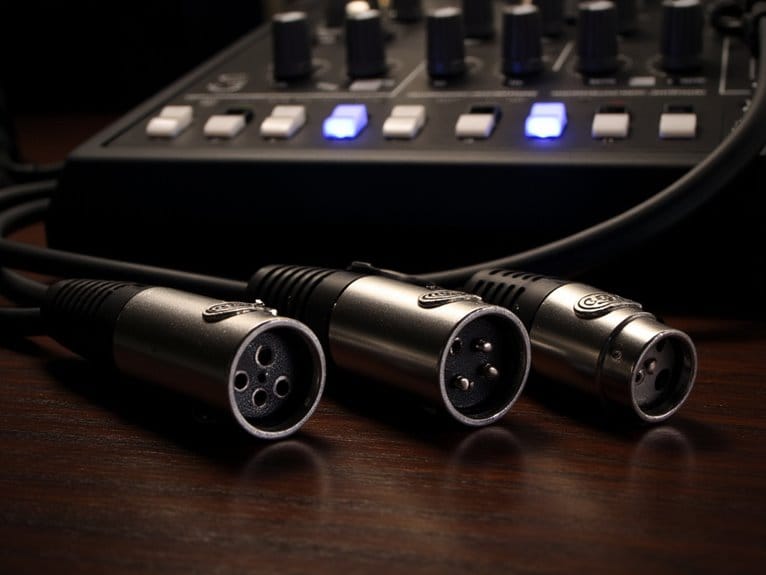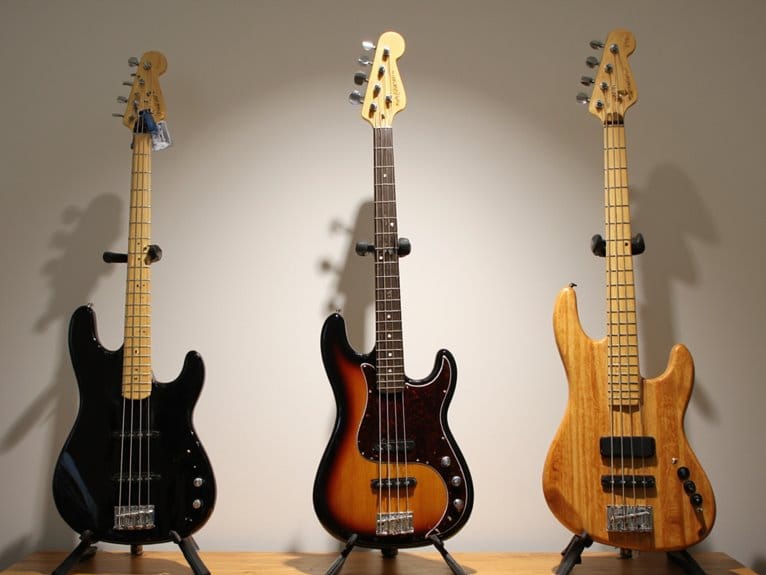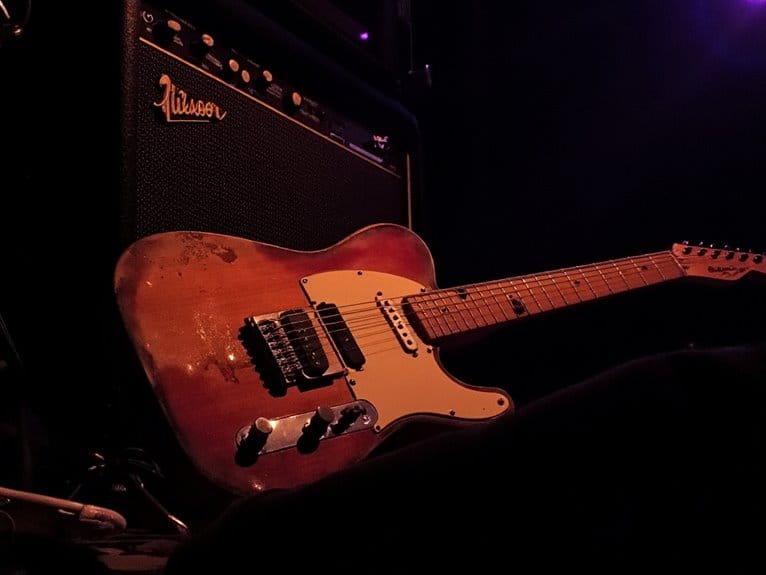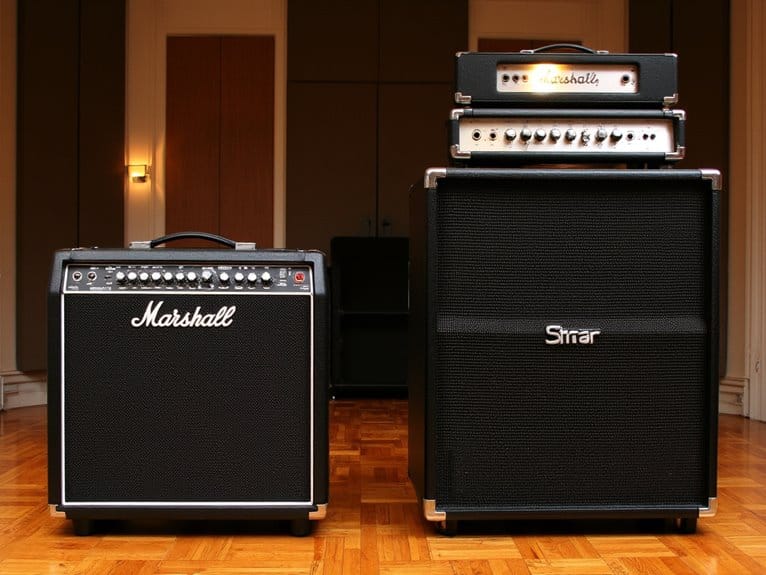Understanding Bass Pickup Configurations
Your bass pickup configuration shapes your tone more than any other component, with single coils delivering bright articulation, split coils providing thick mids with hum cancellation, and humbuckers offering powerful output for aggressive styles. Placement matters substantially-bridge positions yield brightness while neck locations create warmth, and dual-pickup setups like P-J configurations combine both characteristics for exceptional versatility. Modern active electronics expand your tonal control beyond traditional passive designs, and there’s considerably more technical depth to explore.
We are supported by our audience. When you purchase through links on our site, we may earn an affiliate commission, at no extra cost for you. Learn more.
Notable Insights
- Single coil pickups provide bright, articulate tones but are susceptible to electromagnetic interference and hum.
- Split coil configurations offer thicker sound with hum cancellation by capturing different string pairs effectively.
- Pickup placement significantly affects tone: bridge position creates brighter sounds while neck placement produces warmer tones.
- P-J configuration combines neck humbucker’s fatness with bridge single-coil’s clarity for exceptional tonal balance.
- Active pickups deliver higher output with noise reduction, making them ideal for modern performance settings.
Types of Bass Pickups and Their Sonic Characteristics
When you’re exploring the world of bass guitars, understanding pickup types becomes essential since these magnetic transducers fundamentally shape your instrument’s voice, output characteristics, and tonal palette. Different pickup types, such as single-coil and humbucker, offer distinct tonal qualities and responsiveness, making them suitable for various musical styles. For bass players, this understanding is crucial, particularly when crafting intricate melodies or laying down smooth walking bass lines explained. The right pickup can enhance both articulation and warmth, allowing musicians to express their creativity fully.
Single coil brightness delivers articulate, clear tones with strong midrange presence, though you’ll deal with electromagnetic interference in noisy environments.
Split coil punchiness offers thicker sound than singles, featuring pronounced mids and bouncy lows while canceling hum effectively. The split design captures the E and A strings with one coil while the other handles the G and D strings.
Humbucker thickness provides powerful output with emphasized midrange, perfect for aggressive rock and metal applications where consistent tone matters more than touch sensitivity. The design utilizes reverse-polarity winding with two coils to achieve their signature noise-canceling properties.
J Bass clarity combines bright, focused sound with rich harmonic overtones, cutting through mixes with sharp midrange definition that’s versatile across genres. Active pickups deliver higher output and noise reduction compared to their passive counterparts, making them suitable for modern sound characteristics and diverse playing styles.
To further shape your bass tone and enhance these pickup characteristics, many bassists incorporate preamp pedals that provide additional EQ control and signal processing capabilities for both live performances and studio recordings. These preamp pedals can significantly influence the tonal characteristics of your instrument, allowing for a broader range of sounds suitable for various music genres. Additionally, they can help highlight the effects of bass techniques such as slapping, popping, and fingerstyle, making them more pronounced in the mix. By tailoring your sound through these tools, you can achieve a unique and powerful bass presence in any musical setting.
Pickup Placement and Configuration Options
Pickup placement becomes the architectural blueprint of your bass’s tonal foundation, determining where along the string’s vibrating length you’ll capture those magnetic fluctuations that become your sound.
Pickup placement serves as your bass’s sonic DNA, dictating which harmonic frequencies get translated into your distinctive musical voice.
The pickup distance from your bridge dramatically shapes your instrument’s character, with closer positioning yielding brighter, thinner tones while neck-adjacent placement delivers warmer, fuller sounds.
Single-pickup configurations like traditional P-basses offer focused warmth, but dual-pickup setups provide superior versatility.
The popular P-J configuration combines a neck humbucker’s fatness with a bridge single-coil’s clarity, creating exceptional tonal balance through volume blending.
Bridge pickups typically sit one inch from the bridge to capture sufficient string vibration, while neck pickups position near the fretboard without interfering with your playing techniques or truss rod access.
Technical Construction and Modern Innovations
Engineering marvels hide beneath your bass pickup‘s deceptively simple exterior, where decades of magnetic science and materials innovation converge to transform string vibrations into electrical signals.
Modern pickup materials have evolved from basic Alnico magnets to sophisticated neodymium compositions, delivering stronger output and enhanced clarity through superior magnetic flux density. Your coil design directly influences tonal character, with precision-wound copper wire creating the electromagnetic field that captures string movement.
Advanced bobbin materials like engineered plastics withstand temperature fluctuations and mechanical stress better than vintage alternatives, while adjustable polepieces let you fine-tune magnetic field strength per string.
Split-coil humbucking configurations eliminate electromagnetic interference through phase cancellation, and active electronics with onboard preamps provide expanded tonal control that passive pickups simply can’t match. Hexaphonic pickups provide individual string outputs that enable sophisticated MIDI guitar synthesis and multi-tracking capabilities.
On a final note
You’ve now got the foundation to make informed pickup decisions that’ll shape your bass tone for years to come. Whether you’re drawn to the vintage warmth of single-coils, the punchy clarity of split-coils, or the modern versatility of active systems, remember that your playing style and musical context should drive your choice. Don’t overthink it-trust your ears, and you’ll find the configuration that speaks to you. Exploring different pickups can significantly enhance your overall experience, especially when paired with the short scale bass on the market. These instruments offer unique tonal characteristics that complement various pickup configurations, giving you even more options to experiment with. Ultimately, finding the right setup will not only elevate your sound but also inspire your creativity as a bassist. As you expand your tonal palette, consider how a 6 string bass can open up new melodic possibilities and harmonic richness. The additional strings allow for extended range and versatility, making it easier to explore different musical styles and techniques. By experimenting with various pickup configurations on both standard and 6 string bass models, you’ll uncover unique sounds that inspire fresh ideas for your playing.







